Chapter 11a: Communicating Sustainability in the Beauty Industry
“Buy less. Choose well. Make it last.”
-Vivienne Westwood, Fashion Designer and Businesswoman
Objectives
By the end of this chapter, students will be able to:
- Describe the role of communication in promoting sustainability in the beauty industry and how it can improve consumer trust and influence behaviors.
- Identify the major sources of environmental impact in the beauty industry and discuss strategies to mitigate these impacts.
- Evaluate the effectiveness of different sustainable beauty practices, such as ethical sourcing and recycling.
- Discuss the importance of ethical beauty marketing and how it can influence consumer choices and drive demand for sustainable products.
- Recognize the benefits and challenges of sustainable beauty practices and how these fit into broader sustainability models.
- Utilize a variety of strategies for reducing waste in the beauty industry, including packaging innovations and closed-loop systems.
Introduction
In this chapter, referring to “health or beauty products” includes products for the health or aesthetics of our skin (including makeup), hair, or nails. Industries in this chapter may include shampoo, lotion, soap, lip balm, and other products that could be either essential or “good to have”. The cosmetics industry plays a significant role in our daily lives, influencing our self-esteem, social expression, and personal care routines. The Internet, especially social media, has widespread influence over people’s decision-making for such products and the demand for them spans across all ages, ethnicities, and genders, increasing over time. Over time, the rapid growth and reliance on synthetic materials and excessive packaging have led to substantial environmental impacts. Clear and accurate communication can help address consumer concerns, enhance conservation efforts, and mitigate waste. This chapter explores strategies for communicating sustainability in these sectors, covering key areas such as the importance of sustainable beauty products, ethical practices, conscious word choices, and steps we can take as stakeholders in promoting accountability and transparency in the cosmetics industry.
Why Sustainable Beauty is Important
In recent years, the health and beauty industry has witnessed a significant shift towards sustainability, driven by increasing consumer awareness and environmental concerns. This transition is particularly evident in the growing scrutiny of skincare, haircare, and nail products. However, this surge in cosmetics consumption has exacerbated environmental challenges, as products contribute more significantly to landfills each year, particularly through the accumulation of plastic waste. [1] Addressing these issues, the industry must communicate and implement sustainable practices to meet the demands of eco-conscious consumers and mitigate its environmental impact.
Below shows the revenue of baby and child, body, face, and sun protection products from 2014-2026 (predicted in 2022). Although all of them seem to stay the same each year, the “face” related revenue increases every year. Only 202-2022 shows a lag, possibly due to the COVID-19 pandemic.
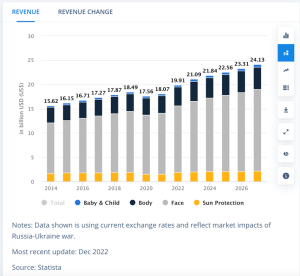
Below shows a bar chart with skin and sun being the largest cosmetics market share, then hair care, then deodorant and fragrance, then makeup. It lacks any specific percentage:
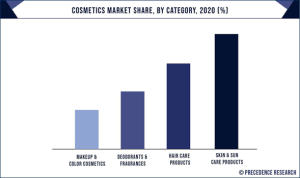
Sun care, face care, body care, hand care items all come under the broad phrase skin care. Women tend to buy much more skin care products than men do. Manufacturers are now creating new skin care products employing modern technologies such as nano particles, nanosome technology, or nanogold. These nanoparticles provide protection from dangerous UV radiation and assist to keep the skin more youthful.
Furthermore, the market for hair care has been consistently increasing due to products being used by all genders and the rising customer taste for saloon and spa hair treatments. The increasing awareness of personal hygiene among males is considered to be the market driver. Moreover, men’s inclination for natural and herbal cosmetics products is always growing, which helps the industry to develop even more. Below is a visual of the prediction of the market for hair care products increasing every year:
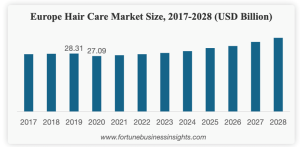
Cosmetics market size from 2022 to 2032 (predicted in 2024) is shown below. It earned 378 billion in 2022 and increased every year. In 2024 it had 419.53 billion. In 2032 it is predicted to rise to 661.12 billion:
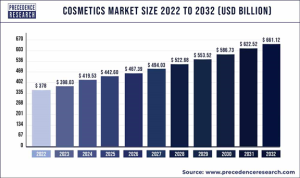
In 2022, the expected size of the US cosmetics industry was 57 billion. With a compound annual growth rate (CAGR) of 5.8%, from 2023 to 2032 the worldwide cosmetics market size was assessed at 378 billion USD in 2022 and is predicted to approach over 661.12 billion USD by 2032. Below are more statistics from the source in the above image:
- The skincare market share in 2022 was expected to be above 41%.
- From 2023 to 2032, the category on hair care is growing at a CAGR of 6.4%.
- From 2023 to 2032, the fragrance market is expanding at a CAGR of 4.6%.
- By end-use, in 2022 the women’s sector had a revenue share of more than 61%.
- From 2023 to 2032, the males’ sector is predicted to expand at a CAGR of 5.9%.
- Based on distribution route, 76% of income in 2022 will have come from the offline sector.
- Over the projection period 2023 to 2032, the internet sector is expanding at a CAGR of 6.3%.
- The skincare segment market share is over 41% in 2022.
Below is a visual of revenue of the cosmetics market worldwide from 2014-2027 (predicted in 2022). It increased every year except for 2020-2021, likely due to the COVID-19 pandemic:
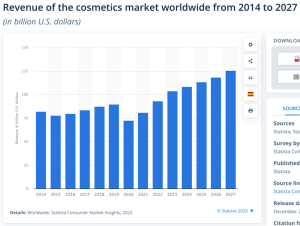
Below shows the cosmetics market share by region in 2020:
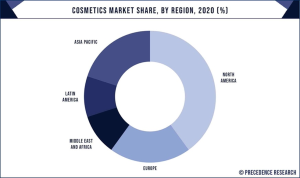
North America dominates the cosmetics market, but Europe and Asia Pacific are not far behind.
Additionally, younger generations are increasingly influenced by online “skinfluencers” for beauty advice, highlighting the significant role of social media in shaping consumer behavior. They are known as “skintellectuals.” Below is the percent of US consumers that use social media to research brands, companies, or products and services. YouTube, Instagram, and TikTok all increased from 2020 to 2021:

The next section will delve deeper into the environmental repercussions of beauty products, focusing on their contribution to landfill waste and the broader ecological footprint of the beauty industry. By examining the lifecycle of these products, from production to disposal, we can better understand the urgent need for communicating sustainable alternatives and the role that both consumers and manufacturers can play in driving this change.
Environmental Impact
The cosmetics industries significantly impact the environment through resource extraction, chemical use, and waste generation. According to the European Union, the beauty sector contributes to 120 billion units of packaging annually, much of which is not recyclable. [7] The beauty industry is notorious for its excessive use of plastic packaging. Many products come in non-recyclable containers, contributing to the global plastic pollution crisis. [8]
The good news is microplastics used in the cosmetics industry has stayed stable and lowering from 2017-2020:
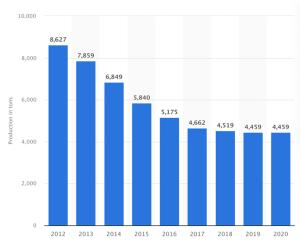
Chemical Use and Pollution
The use of synthetic chemicals in beauty products can lead to water and soil contamination. Persistent organic pollutants (POPs) from cosmetics can accumulate in the environment and pose long-term risks to wildlife and human health. [10] In addition to harming the environment, many beauty products contain harmful chemicals that can affect human health. Ensuring that products are safe and sustainably produced is critical for long-term health and ecological balance. [11]
Resource Extraction
Making beauty products often requires mining natural resources such as minerals and plant extracts. If not controlled responsibly, this may result in habitat damage and biodiversity loss. For instance, sustainability is included throughout the whole life cycle of products by cosmetic giants like Garnier and L’Oréal. Based on its “L’Oréal For The Future – Sustainability Commitments for 2030,” the L’Oréal group was named Global Compact LEAD reasoned on three different premises:
- the transformation and evolution of the industry should respect the limits of the planet;
- the capacity building of the business ecosystem should be promoted to help the transition to a more sustainable world;
- L’Oréal defines measurable goals to assist customers, suppliers, and communities migrate to a more sustainable planet, thereby including them in the transformation processes.
- a contribution for the resolution of the challenges that the world is facing, supporting the urgent environmental and social needs;
- L’Oréal spent 150 million euros in this project, to address some of the more pressing current environmental and social needs, so supporting programs for very vulnerable women, to help to regenerate nature, and so advance the circular economy
- collaboration with NGOs to help to reduce plastic litter. [12]
Designed to solve the full value chain of the brand and therefore reduce or eliminate the environmental effect of its goods, Garnier, a L’Oréal firm, developed the Green Beauty Initiative. By 2025, it also aims to run only renewable energy sources and 100% CO2 neutral plants (the CO2 emissions have already dropped 72%). [13] Below is Garnier’s banner for the Green Beauty website which says “Welcome to the World of Green Beauty” in white text on a green background with “Garnier” on planet Earth with renewable energy sources such as windmills and solar panels on top.
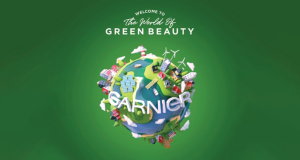
Now that consumers are more informed about the ingredients to avoid, businesses are making more conscious decisions about the products they offer. However, awareness alone is not enough; companies must also carefully choose the words they use to describe and market their products. This is crucial not only for attracting new customers but also for retaining them.
Word Choice Trends in the Cosmetics Industry
The modern cosmetics consumer is increasingly aware of the environmental and health issues associated with synthetic ingredients. This awareness has led to a growing demand for natural, green, and organic products, which are often associated with a healthier lifestyle. The COVID-19 pandemic has further heightened this concern, linking personal health with planetary health. As Oliver Wright from Accenture notes, “People have clearly made a link between the singularity event of COVID-19 and the fact this is linked to planetary change. We are seeing a lot more interest in understanding questions around sustainability and the impact on people’s health.” [15] However, most consumers struggle to distinguish between terms such as green, organic, environmentally-friendly, and sustainable when it comes to cosmetic products. This confusion highlights a significant need for consumer education to ensure that they can make informed choices. [16]
Transition to Sustainable Ingredients
The cosmetics industry is increasingly replacing synthetic materials with more natural alternatives. This transition includes addressing the entire product lifecycle, starting with the ethical sourcing of ingredients and fair-trade practices, the use of recyclable or biodegradable packaging, and waste management. This comprehensive approach ensures that cosmetic companies are not only focusing on environmental sustainability but also embracing social and economic sustainability. [17] [18]
Definitions and Classifications
Terms like organic, natural, and green generally refer to the origin and type of agricultural practices used to obtain the ingredients, but they do not necessarily mean sustainable. Sustainable ingredients address all dimensions of sustainability (environmental, ethical, social, and economic) throughout the product lifecycle. Key points in selecting sustainable raw materials include their composition, biodegradability, and sources, whether natural, synthetic, or naturally derived. [19] Below is an example of facial care products with the label “Organic & natural: pure skin care products.”
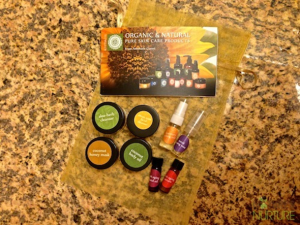
Natural Ingredients
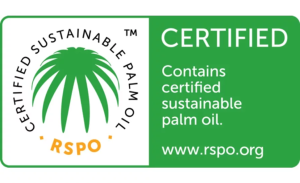
Clean Beauty
Referring to ingredients as “clean” is common since it is hard to define. One example is in the photo of a shampoo bottle below. It says “Earth: clean beauty” then explains what makes it “clean” on the bottom: “free from: sulfates, silicones, parabens, dyes.”

The downward trend shown in the chart below shows that consumers are increasingly more aware of trendy words like “organic” and “natural” and have reported less interest in products with these words:

“Free from”
Regulatory changes are influencing the way companies can market their products. The European Union, for instance, is clamping down on misleading “free from” claims to prevent companies from denigrating entire classes of chemicals. This includes banning claims that a product is “free from” an already banned ingredient or a substance not typically found in such a product. [24] For example, “sulphate-free lipstick” is misleading and makes the product sound more sustainable than it really is, but lipstick doesn’t have sulphate, so it is about as “logical as gluten-free water”. [25]
Sephora, which launched its in-house “clean seal of approval” in 2018 for brands that are “free from” 13 specific ingredients, now bans over 50 ingredients. Beautycounter bans over 1,500 chemicals, promising “peace of mind” without scientific detail. Words like “chemical-free,” “non-toxic,” and “no nasties” imply that the product is “good for you.” However, firms using scare tactics and fraudulent claims is becoming more common.
A ‘chemical’ is a compound, whether pure or artificial. That is not to say that everything containing a chemical is ‘synthetic’ or ‘dangerous.’ Natural components are not necessarily safer than synthetic ones, so the terms “non-toxic” and “no nasties” are deemed marketing jargon. “The way clean beauty brands itself is by saying ‘It will be clean if it’s missing these ingredients,’ and ‘It isn’t clean if it contains any of these ingredients,’ but toxicology works differently,” explains Michelle Wong, a Doctor of Science in chemistry.[26]
“Fragrance-Free”
Research has shown that most firms that put “fragrance” in their ingredient list are dangerous since they use synthetic fillers and phthalates to prolong scents. These “fragrances” may cause cancer, reproductive and developmental harm, endocrine disruption, birth defects, and respiratory problems.[27]
“Free from parabens”
Most consumers now avoid parabens such as methylparaben and propylparaben. Some companies have abandoned or employed fewer effective preservatives and still have “free from parabens” on their product labels. In the 1970s, “preservative-free” was a popular term, but mascaras without preservatives were linked to a number of ocular ulcers caused by pseudomonas. If mascara has no preservatives, it will not adhere to the lashes and could end up in the users’ eyes. [28]
Below, Lexis Clean Kitchen offers a visual on how to spot greenwashing, with a text transcript below it: [29]
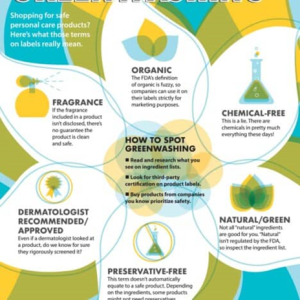
- Fragrance. If the fragrance included in a product isn’t disclosed, there’s no guarantee the product is clean and safe.
- Organic. The FDA’s definition of organic is fuzzy, so companies can use it on their labels strictly for marketing purposes.
- Chemical-Free is a lie. There are chemicals in pretty much everything these days!
- Dermatologist Recommended/Approved. Even if a dermatologist looked at a product, do we know for sure they rigorously screened it?
- Preservative-Free. This term doesn’t automatically equate to a safe product. Depending on the ingredients, some products might need preservatives to prevent mold and bacteria growth.
- Natural/Green. Not all “natural” ingredients are good for you. “Natural” isn’t regulated by the FDA, so inspect the ingredient list.
All in all, cosmetics brands must comply with consumer demand to be relevant, regardless of whether consumers comprehend what is good or bad for them. By addressing these word choice trends and educating consumers, the beauty industry can better align with sustainable practices and meet the growing demand for environmentally and socially responsible products. Now that we know which words to use or avoid, the next section delves more specifically in evaluating beauty practices to be more sustainable.
Evaluating Sustainable Beauty Practices
Ethical Sourcing. Ethical sourcing involves procuring ingredients that are environmentally friendly and produced under fair labor conditions. This practice reduces the environmental footprint and ensures the well-being of workers. [30] Below is a visual of the cosmetics life cycle, starting with design and development, ingredient selection, production, packaging, distribution, consumer use, then post use:
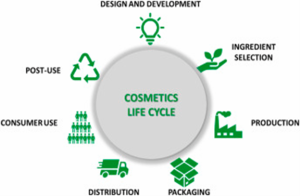
Recycling and Upcycling. Recycling involves breaking down old packaging to create new materials, while upcycling repurposes old containers into new products. These practices can significantly reduce waste and resource consumption. [32] Some of these alternatives, such Cosmos-certified ImerCare® exfoliating products made from 100% natural perlite from volcanic rock, are utilized in face and body scrubs by cosmetic businesses. [33] Klur’s Skin Soil includes brown rice and rosehip seeds, Holifrog’s Como Popp-E Renewal Scrubby Wash contains poppy seeds and bamboo powder, and Reflekt 1’s daily exfoliating face wash uses jojoba esters-based biodegradable microbeads. [34]Upcycling is a great way to address sustainability in industrial processes, but it faces some challenges, such as designing and developing sustainable extraction methods using green chemistry to maximize yield without compromising extract and component stability or environmental impact. The logistics of massive waste volumes still hinder expansion in upcycling. [35] Regardless, below are the top five sustainability attributes fastest growth between 2020-2023. First is “made safe” at around 65%, then “upcycled” at 58%, then compostable at 35%, then carbon neutral/reduced carbon and finally forest stewardship council:

Case Studies: How Companies are Reacting to Public Demands
Lush’s Naked Products. Lush has pioneered the development of “naked” products, which are sold without packaging. This initiative significantly reduces plastic waste and promotes the use of natural ingredients. [37]
The Body Shop’s Community Trade Program. The Body Shop sources ingredients through its Community Trade program, which ensures fair wages and working conditions for suppliers. This initiative supports sustainable agriculture and fair trade practices. [38]
Garnier’s Green Beauty Initiative. Garnier has launched its Green Beauty initiative, focusing on sustainability across its entire value chain. This includes using recycled and recyclable packaging, sustainably sourcing ingredients, and reducing carbon emissions. [39]
The French cosmetics firm Le Rouge Français specializes in “plant-based makeupology,” having pioneered (since the 1990s) alternatives to chemical, non-renewable pigments. [40] Similarly, 100% Pure (USA) solely employs fruit pigments in their natural composition. [41] These include lutein, carotenoids, flavonoids, anthocyanins, lycopene, and other active ingredients that may help the skin.
The EU also established several projects to help fight biowaste:
1.Biowaste is funded by the EC Department of Agriculture and includes programs such as Apropos, which exploits agricultural residues with high protein and oil concentrations, and Transbio, which aims to develop new ingredients from byproducts of the fruit and vegetable processing industries using environmentally friendly biotechnological solutions. [42] [43]
- VOLATILE, which was created to maximize the synthesis of volatile fatty acids from anaerobic fermentation of biowaste; these fatty acids may subsequently be employed in industries such as soap and detergent. [44]
- Oleaf4Value, a biotech initiative led by Natac and financed by the EU, began in 2021 and includes nine nations.
The Role of Certifications
Certifications such as COSMOS, Ecocert, and Fair Trade Certified provide assurance that beauty products meet specific sustainability criteria. These certifications can influence consumer decision-making and promote more sustainable practices. An image of COSMOS-standard, Ecocert, and other certifications can be seen below:
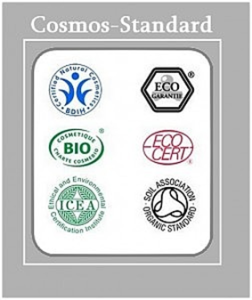
Fair trade can be seen below:
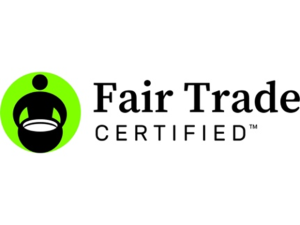
Making Informed Decisions About Cosmetics
As consumers become increasingly aware of the environmental and health impacts of their beauty products, there are several actions we can take to make more informed and responsible choices.
One effective approach is to search for and download mobile apps such as Skin Deep, Detox Me, and Clearya. These apps provide valuable information on potentially dangerous ingredients and rank companies based on their product safety and sustainability practices. In addition to the word choices discussed in this chapter, these apps help consumers educate themselves about common greenwashing strategies. We can also look for certifications and transparent labeling that genuinely reflect a product’s sustainability. [47]
Additionally, consumers can take advantage of SmartLabel, a tool offered by Unilever. SmartLabel allows users to access detailed information about the ingredients and sustainability practices of various products simply by scanning a barcode. [48]
According to Euromonitor International, focusing on fundamental and transparent business practices can create significant value for both companies and consumers. This “back-to-basics” strategy emphasizes the importance of clear, honest communication about product ingredients, sourcing, and environmental impact, enabling consumers to make more informed choices and fostering greater trust between brands and their customers. Below is a great visual of other steps from Euromonitor International, with text transcript below. [49]
By using these resources and staying informed, consumers can play a crucial role in driving the beauty industry towards more sustainable and ethical practices. [50]
Become Tomorrow’s Next Leader
Simplify proposition and focus on science backing
- Adopt minimalism and simplicity as a path to sustainability and to cultivate ethically-minded consumers through simplified ingredient formulations and product hybridity.
- Address price sensitivity and elevate value perceptions through education and science-backed proof of efficacy, and address desire for personal suitability and tailoring.
Advocate and implement purpose
- Develop proposition that embodies personal, community, and planetary health to meet demand for purpose-driven credentials.
- Factor in both environmental and social purpose by reconfiguring supply chains, investment in technology, and placing focus on local community support.
Empower consumers
- Champion social inclusivity and accessibility by targeting underserved consumers and unmet needs around unexplored wellness spaces, as well as price tier flexibility.
- Empower consumers with result-driven solutions, educational content, and community support which enhance self-identity, self-acceptance, and emotional resilience.
Embrace a holistic mindset
- Foster both functional and emotional benefit expressions for ultimate loyalty and trust.
- Innovate with physical and psychological need states in mind and leverage concepts that address nutrition, supplementation, and topicals in one.
- Meet increased demand for natural product formulations and traditional wisdom.
Conclusion
The beauty industry faces significant environmental and social challenges, but effective communication and sustainable practices can drive positive change. By promoting transparency, engaging consumers through social media, and implementing educational campaigns, the industry can enhance its sustainability efforts. Ethical sourcing, recycling, and closed-loop systems are vital practices that can reduce the industry’s footprint. As consumers become more aware of these issues, the demand for sustainable beauty products will continue to grow, fostering a more sustainable and responsible industry.
[1] Green, J., & Brown, L. (2019). Environmental impact of beauty products. Journal of Sustainability Studies, 12(3), 45-59.
[2] Martins, A. M., & Marto, J. M. (2023). A sustainable life cycle for cosmetics: From design and development to post-use phase. Sustainable Chemistry and Pharmacy, 35, 101178. https://doi.org/10.1016/j.scp.2023.101178
[3] Hair Care Market Size, Share & Industry Analysis, By Product (Hair Colorants, Shampoo, Conditioner, Hair Oil, and Others), By Distribution Channel (Supermarket/Hypermarket, Specialty Stores, Online Stores, and Others), By and Regional Forecasts, 2024-2032. (2024). Fortune Business Insights. https://www.fortunebusinessinsights.com/hair-care-market-102555
[4] Cosmetics Market Size to Hit Around USD 661.12 Bn By 2032. (n.d.). https://www.precedenceresearch.com/cosmetics-market
[5] Johnson, A. (2021). The rise of skinfluencers: Social media and beauty. Online Influences in Modern Consumer Behavior, 5(2), 30-47; Smith, R. (2020). Gender differences in perceptions of skincare. Beauty and Health Research, 18(4), 65-72.
[6] Rollinson, A. (2023, August 7). Sustainability and Social Purpose in Hair Care. Euromonitor. https://www.euromonitor.com/article/sustainability-and-social-purpose-in-hair-care
[7] Reducing plastic waste in the cosmetics industry. (2020). European Commission. https://ec.europa.eu/
[8] The impact of plastic packaging in cosmetics. (2020). Plastic Pollution Coalition. https://www.plasticpollutioncoalition.org/
[9] Microplastics production in cosmetics industry in EU 2012-2020 | Statista. (2023, November 29). Statista. https://www.statista.com/statistics/985029/microplastics-production-in-cosmetics-industry-in-eu/
[10] United Nations Environment Programme. (2021). The impact of synthetic chemicals in cosmetics on the environment. Retrieved from https://www.unep.org/
[11] Environmental Working Group. (2021). Ensuring product safety and sustainability in cosmetics. Retrieved from https://www.ewg.org/
[12] Product environmental & social impact labelling methodologies. (2020). L’Oréal. https://www.loreal.com/-/media/project/loreal/brand-sites/corp/master/lcorp/documents-media/publications/loreal-pil-methodologie-en01.pdf
[13] Green Beauty. (2020). Garnier. https://www.garnier.in/green-beauty
[14] Think Marketing. (2020). How Garnier Keeps Creating and Innovating for Green Beauty. Think Marketing Magazine. From https://thinkmarketingmagazine.com/how-garnier-keeps-creating-and-innovating-for-green-beauty/
[15] Culliney, K. (2021a). COVID-19 and consumer behavior. Accenture Reports.
[16] Bom, S., et al. (2019). Sustainability in cosmetics. Cosmetic Science, 12(3), 45-59.
[17] Cosmetics Europe. (2012). Environmental impact of cosmetics. Industry Report.; Bom, S., et al. (2019). Sustainability in cosmetics. Cosmetic Science, 12(3), 45-59.
[18] Citation Needed
[19] Natrue. (2022). Standards for natural and organic cosmetics. Natrue Publications; Bom, S., et al. (2019). Sustainability in cosmetics. Cosmetic Science, 12(3), 45-59.
[20] Ummyousef, S. (2025). Best Natural Skin Care Line. Natures Nurture Blog. From https://naturesnurtureblog.com/best-natural-skin-care-line/
[21] L’Oréal. (2022e). Responsible Mica Initiative. Corporate Social Responsibility Report; RSPO. (2022). Certified Sustainable Palm Oil. Sustainability Standards.
[22] Earth Clean Beauty Moisture and Repair Shampoo. (n.d.). Walmart. From https://www.walmart.com/ip/earth-Clean-Beauty-Moisture-and-Repair-Shampoo-with-Argan-Oil-Aloe-for-All-Hair-Types-12-fl-oz/989598240
[23] Stelmaszczyk, O. (2023, August 4). The Rise of Ingredient Led Beauty. Euromonitor. https://www.euromonitor.com/article/the-rise-of-ingredient-led-beauty?ite=55599&ito=529&itq=a67b1145-fc67-400f-bd68-b2c1c07d85f8&itx%5Bidio%5D=5102580
[24] Nowak, K., et al. (2021). Regulation of cosmetic ingredients in the EU. Journal of Cosmetic Science, 15(1), 12-29; Cosmetics Europe. (2012). Environmental impact of cosmetics. Industry Report.
[25]Tang, W. S. (2020). Has Clean Beauty Become a Misinformation Movement? Elle Canada. https://www.ellecanada.com/beauty/clean-beauty-misinformation-movement
[26] Tang, W. S. (2020). https://www.ellecanada.com/beauty/clean-beauty-misinformation-movement
[27] Tang, W. S. (2020). https://www.ellecanada.com/beauty/clean-beauty-misinformation-movement
[28] Tang, W. S. (2020). https://www.ellecanada.com/beauty/clean-beauty-misinformation-movement
[29] Lexis Clean Kitchen. (2022). Greenwashing and how to avoid it. Lexis Clean Kitchen. Retrieved from Lexis Clean Kitchen.
[30] Boström, M., & Micheletti, M. (2016). Introducing the sustainability challenge of textiles and clothing. Journal of Consumer Policy, 39(4), 367-375. doi:10.1007/s10603-016-9336-6
[31] Martins, A. M., & Marto, J. M. (2023). A sustainable life cycle for cosmetics: From design and development to post-use phase. Sustainable Chemistry and Pharmacy, 35, 101178. https://doi.org/10.1016/j.scp.2023.101178
[32] González, A., García, S., & Margallo, M. (2019). Recycling and upcycling of packaging materials: Environmental and economic assessment. Retrieved from https://core.ac.uk/download/pdf/301138773.pdf
[33] Imerys. (2022). A natural alternative to microplastic beads. https://www.imerys.com/markets/cosmetics-personal-care/benefits/exfoliation
[34] Molvar, K. (2020). To scrub, slough, or chemically dissolve? Experts weigh in on the ultimate guide to winter exfoliation
https://www.vogue.com/article/skincare-mechanical-vs-chemical-vs-physical-exfoliation
[35] Cultor, R. (2022). What upcycling, waste reduction looks like with cosmetic products today. CosmeticsDesign USA. https://www.cosmeticsdesign.com/Article/2022/11/08/upcycling-in-cosmetics-ingredients-and-formulation?utm_source=newsletter_daily&utm_medium=email&utm_campaign=10-Nov-2022&cid=DM1041983&bid=2079326512
[36] Zuniga, J. (2024, July 22). Unlocking Sustainability Opportunities in Beauty and Personal Care. Euromonitor. https://www.euromonitor.com/article/unlocking-sustainability-opportunities-in-beauty-and-personal-care?ite=63624&ito=529&itq=c4e0a6f3-4adb-42bf-8d17-8c778c501a81&itx%5Bidio%5D=8754811
[37] Naked – We are Lush. (2023, November 27). We Are Lush. https://weare.lush.com/lush-life/our-values/naked/
[38] Fair Trade in Beauty | Community Fair Trade | The Body Shop®. (n.d.). The Body Shop®. https://www.thebodyshop.com/en-gb/about-us/brand-values/community-fair-trade/a/a00009
[39] COMMITTED TO GREENER BEAUTY FOR MORE OF US. (n.d.). Garnier. https://www.garnier.in/green-beauty
[40] Le Rouge Français. (2022). Plant-based makeupology. Company Website.
[41] 100% Pure. (2019). Fruit pigments in makeup. Company Report.
[42] Dell’Acqua, G. (2017). Biowaste and its applications. European Biotech Journal, 22(4), 75-85.
[43] Goyal, R., & Jerold, J. (2021). Transbio: Innovative biotechnological solutions. Agricultural Biotechnology, 9(1), 34-42.
[44] European Commission. (2021). VOLATILE project overview. EU Research Projects.
[45] Meiss, A. (2011, March 2). Launch of COSMOS-standard certification. COSSMA. https://www.cossma.com/marketing/article/launch-of-cosmos-standard-certification-14568.html
[46] Fair Trade USA, Chobani launch certification program for U.S. dairy industry. (2021, May 6). 2021-05-06 | Dairy Foods. https://www.dairyfoods.com/articles/95010-fair-trade-usa-chobani-launch-certification-program-for-us-dairy-industry
[47] Lexis Clean Kitchen. (2022). Greenwashing and how to avoid it. Lexis Clean Kitchen. Retrieved from Lexis Clean Kitchen
[48] Unilever. (2022). SmartLabel by Unilever. Unilever USA. Retrieved from Unilever
[49] Euromonitor International. (2021). Key strategies for creating value through back-to-basics. Euromonitor International. Euromonitor.
[50] Citation needed